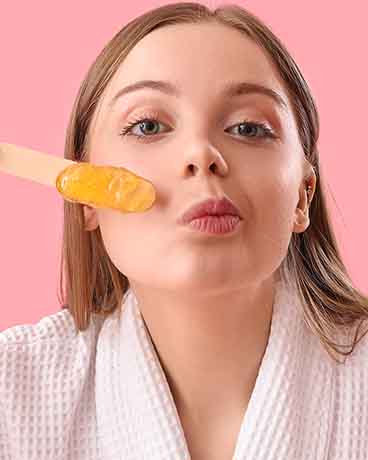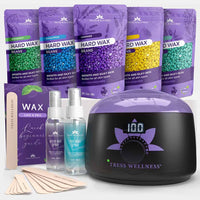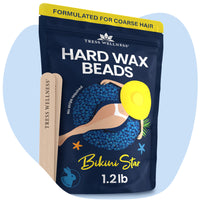Peach fuzz, sideburns, nose, upper lip and chin hair, there's a lot of ground to cover if you are looking for hair removal on your face. And if you’re seeking a long-lasting and effective way to eliminate unwanted facial hair, then face waxing might be the solution you’ve been searching for. In this blog post, we will dive into the world of face waxing, its benefits, and how to prepare for and perform this popular beauty treatment. So, let’s get started on your journey to smoother, fuzz-free skin!
Key Takeaways
-
Face waxing offers a versatile solution for removing facial hair with long-lasting results and weakened regrowth.
-
Achieve smooth skin with enhanced makeup application and brighter complexion, as well as reducing ingrown hairs by exfoliating dead skin cells.
-
Proper cleansing, exfoliation, and aftercare steps such as soothing the skin & avoiding sun exposure are essential to maintain a successful face waxing experience.
The Benefits of Face Waxing
-
Long-lasting results: Unlike shaving or hair removal creams, facial hair removal through face waxing offers long-lasting results. It removes hair from the root, delaying regrowth and keeping your skin smooth for weeks.
-
Exfoliation: Waxing removes not only unwanted hair but also dead skin cells. This gentle exfoliation process reveals a fresh layer of skin, giving you a brighter complexion and smoother texture.
-
Weakened hair follicles: Regular waxing weakens hair follicles, leading to finer and less noticeable regrowth over time.
-
Versatility: This beauty treatment provides a versatile solution for various facial hair types, from the delicate upper lip to the stubborn chin hair.
-
Affordability and accessibility: In comparison to other hair removal methods, such as laser hair removal or depilatory creams, waxing is often more affordable and accessible for removing body hair.
-
At-home or professional options: Face waxing can be performed at home with DIY kits or by a professional at a salon, giving you the flexibility to choose the best option for your needs.
-
Reducing Ingrown Hair: Face waxing is a superior method for reducing the occurrence of ingrown hair. Unlike shaving or depilatory creams, which only remove hair at the surface level, face waxing removes hair from the root. This allows the hair to grow back with a softer, tapered edge, making it less likely to curl back into the skin and cause ingrown hair.
Preparing for a Face Waxing Session
In the following subsections, we will discuss the two main steps in preparing your skin for a face waxing session: skin cleansing and exfoliating. By following these guidelines, you’ll set yourself up for a successful and comfortable waxing experience.
Skin Cleansing
Before waxing, follow these steps to prepare your skin:
-
Gently cleanse your skin to eliminate dirt, oil, or makeup which may hinder the wax’s effectiveness.
-
Use a gentle pre-wax spray specifically designed for this purpose to ensure your skin is properly prepared for the waxing process.
-
Avoid cleansers with fragrances or dyes, as these can irritate the delicate facial skin.
Once your skin is clean, make sure the area is completely dry before applying the wax. This is important, as any moisture left on the skin can prevent the wax from adhering correctly, which may lead to a less effective hair removal experience.
Exfoliating
Exfoliating your skin a day or two before waxing serves as another key step in the preparation process. This helps remove dead skin cells from the surface, allowing the wax to adhere more effectively to the hair rather than the skin.
To exfoliate your skin, use a gentle exfoliator, such as a body scrub or polish, a few days before your waxing appointment. Avoid using harsh scrubs on the day of the waxing, as this can cause irritation and make the waxing process more uncomfortable.
By properly exfoliating your skin, you’ll ensure a smoother and more effective waxing experience.
Face Waxing Techniques and Tools

As we delve into the realm of face waxing, it's important to familiarize yourself with the essential tools required for this process. Here's a list of items you'll need:
-
Wax: Choose between soft and hard wax depending on your skin sensitivity and the area of the face you're waxing.
-
Wax Warmer: This heats up the wax to the right temperature. Some DIY kits come with a wax warmer included.
-
Waxing Strips: If you're using soft wax, you'll need strips to remove the wax and hair. Hard wax doesn't require strips as it hardens and is pulled off directly.
-
Applicator Sticks or Spatulas: These tools help you apply the wax evenly on your skin.
-
Pre-Wax Spray or Cleanser: This is used to clean the skin before applying wax and helps the wax adhere better to the hair.
-
Post-Waxing Soothing Spray: After waxing, it's essential to soothe the skin to reduce redness and irritation.
-
Tweezers: These can be used to remove any remaining stray hairs after waxing.
-
Mirror: A good-sized mirror is crucial to clearly see the area you're waxing and ensure you're doing it correctly.
By ensuring you have all these tools at hand, you'll be well-prepared for a successful face waxing session.
Soft Wax vs. Hard Wax
Soft wax and hard wax are the two primary types of wax used for face waxing. Here are the key differences between the two:
-
Soft wax is applied thinly and removed with a strip.
-
Hard wax is applied thicker and removed without a strip.
-
Soft wax adheres more to the skin, providing a gentle exfoliation and effectively grabbing fine hairs.
-
Hard wax is gentler on the skin and more effective at removing hair in sensitive areas, as it adheres to the hairs rather than the skin.
@tresswellness_waxingkit When did you first try hard wax? So many people don’t know the difference between hard wax and soft wax but they are VERY different! #hardwax #waxing #howtowax #stablediffusion #USA ♬ original sound - Tress Wellness Waxing Kit 💜
When deciding between soft and hard wax, take into account skin sensitivity, hair type and texture, and hair growth patterns. A careful evaluation of each wax type’s pros and cons will guarantee the best results tailored to your needs. Tress Wellness's hard wax beads are perfect for face waxing because they are gentle on the skin, approved by dermatologists and formulated especially for sensitive areas like the face, the bikini area and the genitals.
DIY Face Waxing Kits
DIY face waxing kits are a popular choice for those who prefer the comfort of home waxing. These kits typically include wax strips or wax beads, a wax warmer or microwave-safe container, applicator sticks or spatulas, and post-waxing soothing lotions or oils. Tress Wellness Waxing Kit is perfect for face waxing because it comes with all the tools that are needed for at-home waxing beginners.
Adhering closely to the instructions provided with your DIY face waxing kit is key to achieving optimal results and avoiding complications. By doing so, you can achieve salon-quality results from the comfort of your own home.
Step-by-Step Guide to Face Waxing
Now that we've discussed the benefits and preparation for face waxing, let's move onto the actual process. In this section, we'll provide a detailed, step-by-step guide on how to carry out a face waxing session, ensuring you get the best possible results.
@tresswellness_waxingkit Face waxing #sosatisfying #eyebrowwaxing #nosewax #upperlipwax #waxing #hardwax #waxkit #USA ♬ CUFF IT - Beyoncé
-
Prepare Your Skin: Start by cleansing your face to remove any makeup, oil, or dirt. Use a gentle cleanser and pat your skin dry. If possible, exfoliate your skin a day or two before your waxing session to remove dead skin cells and allow for better wax adherence.
-
Heat the Wax: If you're using a wax warmer, turn it on and let the wax heat up until it reaches a honey-like consistency. If you're using microwaveable wax, follow the instructions on the package for heating times.
-
Divide and Conquer: To ensure an effective and manageable face waxing session, it's best to divide your face into sections such as the upper lip, chin, cheeks, and forehead. Work on one section at a time, applying and removing the wax before moving on to the next area. This approach offers greater control over the process and helps to achieve more precise results.
-
Apply the Wax: Using a spatula or applicator stick, apply a thin layer of wax in the direction of hair growth. Make sure to leave a bit of extra wax at the end of the strip, this will be your "tab" for removal.
-
Remove the Wax: Wait for the wax to cool slightly, then pull the skin taut with one hand and quickly remove the wax in the opposite direction of hair growth with the other hand. Remember, the faster you pull, the more effective the hair removal will be.
-
Soothe Your Skin: After waxing, apply a soothing lotion or aloe vera to help calm any redness or irritation. Avoid any harsh skincare products or sun exposure for at least 24 hours after waxing.
-
Maintain the Results: To keep your skin smooth and hair-free, aim to wax every two to four weeks, depending on your personal hair growth. Between waxing sessions, keep your skin moisturized and exfoliate regularly to prevent ingrown hairs.
Remember, everyone's skin reacts differently to waxing, so it's always a good idea to do a patch test on a small area of skin before waxing your entire face. If you have any concerns or if your skin reacts badly to the wax, consult with a professional.
Aftercare Tips for Face Waxing

Proper aftercare is just as important as the waxing process itself. Following the correct aftercare steps can help maintain the results of your face waxing and prevent potential irritation or complications.
Let us discuss the essential aftercare tips, such as soothing the skin and avoiding sun exposure, to ensure your skin stays healthy and radiant after your face waxing session.
Soothing the Skin
Post-waxing, and soothing your skin is imperative to minimize redness and discomfort. Here are some ways to calm your skin after waxing:
-
Apply a calming, unscented lotion to the waxed area to reduce inflammation and promote healing.
-
Use aloe vera gel, which has anti-inflammatory properties and can soothe irritation.
-
Keep the waxed area moisturized to prevent dryness and further irritation.
By following these tips, you can ensure that your skin stays calm and healthy after waxing.
Wait a few hours after your waxing session before applying any soothing lotions or gels to avoid causing burning or irritation. By properly soothing your skin, you’ll help ensure a comfortable and successful face waxing experience.
Skip Harsh Skincare Products
Steer clear of harsh skincare products, especially those containing retinoids or acids, for a few days after waxing your facial hair. These ingredients can be too abrasive for sensitive, waxed skin and may lead to breakouts and redness.
Retinoids (Retinol, Tretinoin)
Known for their skin-renewing properties, retinoids can be too intense for freshly waxed skin. These compounds may heighten sensitivity, leading to redness and potential peeling. Consider holding off on using retinoid-containing products around your delicate facial skin for a few days after hair removal on your face.
Alpha Hydroxy Acids (AHAs) and Beta Hydroxy Acids (BHAs)
AHAs (e.g., glycolic acid) and BHAs (e.g., salicylic acid) are potent exfoliants, making them a go-to for skincare enthusiasts. However, post-waxing, these acids can be overly harsh, exacerbating sensitivity and potentially causing irritation. Opt for milder alternatives after waxing facial hair.
Vitamin C (Ascorbic Acid)
While Vitamin C is celebrated for its brightening properties, high concentrations of ascorbic acid may be too intense for freshly waxed skin. Until your skin fully heals after facial hair removal, choose gentler Vitamin C formulations to maintain comfortable post-waxing facial hair.
Benzoyl Peroxide
Often used to combat acne, benzoyl peroxide can be aggressive on sensitive skin, especially after a facial wax. Avoid this ingredient for a few days to prevent unnecessary irritation and potential dryness.
Fragrances and Harsh Chemicals:
Fragrances and certain harsh chemicals found in skincare products can be harsh on your face after you wax face. Opt for fragrance-free or hypoallergenic formulations to reduce the risk of irritation and maintain a comfortable post-waxing experience.
Alcohol-Based Products:
Alcohol-based toners or astringents may cause a stinging sensation and dryness, particularly on freshly waxed face., particularly on freshly waxed face. Choose alcohol-free alternatives to maintain hydration and avoid unnecessary discomfort and irritation after a face wax.
Hands Off Policy
Resist the temptation to touch or scratch the waxed area. Your face is more susceptible to bacteria after a face wax and touching may lead to infections or breakouts. Maintain a hands-off policy for a couple of days after a face wax.
Stay Makeup-Free Initially
Give your face a makeup break for the first 24 hours post face wax. Makeup may contain chemicals that can irritate your freshly waxed skin. Avoid irritation and allow your delicate facial skin to breathe and recover before applying any cosmetic products.
Avoid Hot Baths and Saunas
Steer clear of hot baths, saunas, or steam rooms for the initial 48 hours. Exposure to excessive heat can open pores and increase the risk of irritation. Opt for cooler showers to protect your skin after waxing your eyebrows.
Take Care of Your Skin Barrier
Waxing does not strip your skin of its barrier, so the chances of breaking out with waxing are lesser. But in any case after your eyebrow waxing, you should incorporate calming ingredients like cica and aloe vera into your skincare routine. A good ceramide-based moisturizer also goes a long way in protecting your skin’s barrier.
Avoiding Sun Exposure
Shielding your waxed skin from sun exposure is another fundamental step in aftercare. Since waxing removes the uppermost layer of the skin, it becomes more vulnerable to the sun’s rays. Exposing your freshly waxed skin to the sun can lead to sunburn, irritation, and damage.
To prevent these issues, avoid sun exposure for at least 24 to 48 hours after your face waxing session. By taking the necessary precautions, you can maintain your smooth, hair-free skin without any unwanted complications.
Frequently Asked Questions
Is it a good idea to wax your face?
It is generally safe to wax your face as it can provide nourishment and protection for the skin, exfoliate and reveal smoother skin with an even tone. However, there is a higher risk of irritation and rashes due to facial skin being more sensitive than other parts of the body. It's best to proceed with caution if you're on certain medications or have a skincare regimen.
What is the downside of waxing face?
Facial waxing can be painful, cause irritation and skin darkening, and leave you waiting for hair to grow back. Additionally, there is a risk of skin rashes, bumps, and ingrown hairs as well as temporary redness and sensitivity.
Is it better to shave or wax your face?
Overall, waxing is a better option for sensitive skin as it exfoliates and removes dead skin cells. Shaving can cause ingrown hairs, reactions to the metal of the razor and can dry out the skin.
How long does a face wax last?
Facial waxing should be done every 2-3 weeks to maintain your desired results. Underarm waxing should also be done every 2-3 weeks for best results.
Can I wax my face if I have sensitive skin?
Yes, you can wax your face if you have sensitive skin. Just make sure to choose a gentle type of wax, such as hard wax, and take appropriate aftercare measures to avoid any irritation.
@tresswellness_waxingkit Wax you can use on your face and other places 😺 #waxing #facewax #eyebrowwax #waxingforbeginners #hardwax #waxkitamazon #USA ♬ original sound - Tress Wellness Waxing Kit 💜
Can I apply makeup after face waxing?
After face waxing, it's best to wait at least 24 hours before applying makeup. This gives your skin time to recover and reduces the risk of clogging pores and causing breakouts.
Will face waxing cause wrinkles?
No, face waxing does not cause wrinkles. However, if you have very sensitive or loose skin, you may want to consult with a professional before waxing to avoid any potential skin damage.
Can I exfoliate after face waxing?
It's best to wait 24 to 48 hours before exfoliating after face waxing. This allows your skin time to recover and reduces the risk of irritation.
Is face waxing safe during pregnancy?
Yes, face waxing is generally safe during pregnancy. However, due to hormonal changes, your skin may be more sensitive than usual. Always do a patch test or consult with a professional if you're unsure.
Can face waxing lighten skin?
Waxing does not lighten the skin. It removes hair from the root and exfoliates the top layer of skin, which can make your skin appear brighter, but it does not change your skin's pigmentation.
Face waxing is a popular and effective method for removing unwanted facial hair and achieving smooth, radiant skin. By following proper skin preparation, choosing the right waxing technique, and adhering to essential aftercare tips, you can enjoy the benefits of face waxing and enhance your overall appearance. So, why not give face waxing a try and experience the transformative effects for yourself?
Comment below if you found this blog helpful. Share this with a friend who needs help with face waxing.
Before embarking on the journey of face waxing, properly preparing your skin is vital for achieving optimal results. Proper skin preparation is a crucial step in the waxing process, as it helps the wax adhere more effectively to the hair and reduces the risk of irritation or complications.



